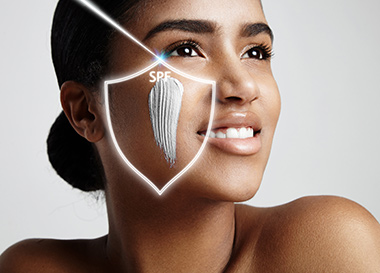

Dr. Jason K Rivers MD, FRCPC, FAAD, FCDA
 “Global warming is taking place and humankind is playing a role.”
“Global warming is taking place and humankind is playing a role.”
You may wonder what global warming has to do with our skin, but it’s having a significant effect.
The last few months have been unseasonably old in British Columbia – certainly part of the global change to our weather systems, caused in some measure by our own neglect of planet earth. But with the colder winters, we’re also experiencing an increase in the number of hot and sunny summer days.
Sun exposure has long been associated with a potential for skin damage, and everyone can develop problems from either acute or prolonged exposure to the sun’s ultraviolet radiation that manifests as sunburn, premature skin aging (skin redness, uneven skin colour, wrinkles) or skin cancer. Skin cancer rates continue to increase and this is due in large part to excessive sun exposure.
The ancient Egyptians knew about sun damage; a tomb painting at Thebes, dated to approximately 3200 BCE, depicts a man wearing a straw hat. Today, we still realize that hats and other clothing (shirts, long pants, etc.), along with sunglasses and seeking shade are simple and effective ways to reduce sun exposure. However, we’re also an active society, and cycling or swimming in long pants during the summer is a drag – both aerodynamically and socially!
For almost a century, sunscreens have existed to help reduce sunburn on exposed skin, but we now know that appropriately formulated products can also help to prevent premature aging of the skin and reduce the risk of developing skin cancer.
Sunscreen updated
Sunscreen usage has changed, with more people applying these products more frequently and in larger amounts. At the same time, sunscreen formulations have evolved as companies innovate.
Currently there are many different sunscreen ingredients on the market and for years they’ve been accepted as safe and effective for human use. However, in February 2019, the U.S. Food and Drug Administration (FDA) issued a proposal that would update regulatory requirements for most sunscreen products in the United States.
This significant action is aimed at bringing sunscreens up to date with the latest science to better ensure consumers have access to safe and effective preventative sun care options. Among its provisions, the proposal addresses sunscreen active ingredient safety, dosage forms, and sun protection factor (SPF) and broad-spectrum requirements. It also proposes updates to how products are labeled to make it easier for consumers to identify key product information.
The FDA permits certain over the counter (OTC) drugs to be marketed without approved new drug applications because they’re generally recognized as safe and effective (GRASE) and not misbranded.
In the proposed rule, the FDA makes the following recommendations for sunscreens marketed without FDA-approved applications:
- Proposes that, of the 16 currently marketed active ingredients, two ingredients – zinc oxide and titanium dioxide – are GRASE for use in sunscreens; two ingredients – PABA and trolamine salicylate – are not GRASE for use in sunscreens due to safety issues. There are 12 ingredients for which there are insufficient safety data to make a positive GRASE determination (cinoxate, dioxybenzone, ensulizole, homosalate, meradimate, octinoxate, octisalate, octocrylene, padimate O, sulisobenzone, oxybenzone, avobenzone).
- Proposes that dosage forms that are GRASE for use as sunscreens include sprays, oils, lotions, creams, gels, butters, pastes, ointments and sticks. Powders are proposed to be eligible for inclusion in the monograph, but additional data are requested before powders can be included in the monograph. Wipes, towelettes, body washes, shampoos and other dosage forms are proposed to be categorized as new drugs because the FDA has not received data showing they are eligible for inclusion in the monograph.
- Proposes to raise the maximum proposed SPF value on sunscreen labels from SPF 50+ to SPF 60+
- Proposes to require sunscreens with an SPF value of 15 or higher to also provide broad spectrum protection and that, for broad-spectrum products, as SPF increases, the magnitude of protection against UVA radiation also increases. These proposals are designed to ensure that these products provide consumers with the protections that they expect.
- Proposes new sunscreen product label requirements to assist consumers in more easily identifying key information, including the addition of the active ingredients on the front of the package; require sunscreens with SPF below 15 to include “See Skin Cancer/Skin Aging alert” on the front panel; require font and placement changes to ensure SPF, broad spectrum, and water resistance statements stand out; and Include alphabetical listing of active ingredients on the front panel
- Proposes that products that combine sunscreens with insect repellents are not GRASE.
These changes will have a major impact on sunscreen products in Canada and the information is relevant to us.
Sunscreen and antioxidants combined
Beyond the FDA proposals above, we also know that adding antioxidants to sunscreen formulations can improve the product’s stability in the sun and increase the “safe” time of sun exposure. Antioxidants such as vitamins E and C are molecules that inhibit the oxidation of other molecules, they work by neutralizing the sun’s rays on skin cells before the cells start to incur damage. The key is to know which new sunscreens use antioxidants best. Price does not necessarily determine quality. (Packaging, advertising, branding, and image all affect the cost of a product as well.) Often the thing to consider—besides reading the ingredient list—is a company’s reputation as a brand that is backed by research.
Sunscreens are providing passive protection by absorbing or reflecting harmful UV rays from the skin. But by adding antioxidants to sunscreens, they could offer a second, active level of protection. A study published in the Journal of the American Academy of Dermatology (AAD) recommends the use of a sunscreen that provides protection against both ultraviolet A (UVA) and ultraviolet B (UVB) rays. And it certainly doesn’t advocate just relying on antioxidants, however, the article does back antioxidants as a way of boosting our natural immunity to sun damage. Adding antioxidants to sunscreen is an innovative approach that could represent the next generation of sunscreens, which would not only filter UV radiation, but also offer other skin health benefits.
Sunscreens of tomorrow
What of the future? I started this dialogue reflecting on the weather and global warming. To be sure, something is taking place and humankind is playing a role. Recently, the State of Hawaii has recognized that certain ingredients in sunscreens may be contributing to the death of coral reefs. As such, by 2020 sunscreens containing these chemicals will be banned. As science advances, I hope we will be able to protect our skin and contribute to the saving of our planet simultaneously.
 Dr. Jason K Rivers, MD, FRCPC, FAAD, FCDA is a Clinical Professor, Department of Dermatology and Skin Science, University of British Columbia and the Medical Director, Pacific Derm, Vancouver, British Columbia.
Dr. Jason K Rivers, MD, FRCPC, FAAD, FCDA is a Clinical Professor, Department of Dermatology and Skin Science, University of British Columbia and the Medical Director, Pacific Derm, Vancouver, British Columbia.